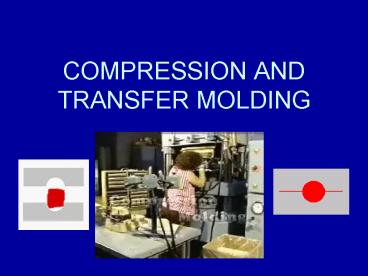COMPRESSION AND TRANSFER MOLDING PowerPoint PPT Presentation
1 / 33
Title: COMPRESSION AND TRANSFER MOLDING
1
COMPRESSION AND TRANSFER MOLDING
2
Compression Molding
- The process of molding a material in a confined
shape by applying pressure and usually heat. - Almost exclusively for thermoset materials
- Used to produce mainly electrical products
3
CompressionMolding
4
Background
- One of the oldest known molding processes.
- Widely used to produce articles from
thermosetting and thermoplastic materials. - The plastic material is placed in a mold cavity
and formed by heat pressure. - Most compression-molding equipment is typically
sold by the press or platen rating. - A force of 2900psi is usually required for
moldings up to 1inch (25 mm) thick. An added
725psi should be provided for each 1inch (25 mm)
increase.
5
In terms of processing, the past begins with the
manufacturing process known as compression
molding
The very first plastic products included items
such as, buttons, brush and mirror handles that
were compression molded.
All were relatively small and had relatively
simple geometries.
Hand made compression mold for a hand held mirror
(c.1870).
6
The items shown below were compression molded
from a shellac based thermoplastic molding
compound known as Florence compound. Its
inventor, Alfred Critchlow, founded the Pro
Corporation, Florence MA in 1847. Pro is said to
be the very first plastics molding company.
Daguerreotype case (c.1856).
Hand held mirror frames (c.1866).
7
Over the years, compression molding (and transfer
molding) press capacities (size) increase so that
larger thermoplastic and thermoset plastic parts,
such as this radio housing, could be molded.
Trimming flash from Ekco radio cabinets (c.1934).
Large scale compression molding press (c.1935).
8
PROCESS
9
(No Transcript)
10
Compression Molding a Composite
11
Stages in Compression molding cycle
- The various stages of the compression molding
cycle time can be represented as a function of
the force required to close the mold at a
constant rate. In the plastication stage (tlttf)
the force increases rapidly as the polymer feed
is compressed and heated. The second stage flow
commences, once the yield stress of the elastomer
is exceeded. tc is the point at which the mold
fills and compression of the melt occurs.
Ideally, to aid mold filling the majority of
chemical reaction should take place after tc.
12
Transfer Molding
- A process of forming articles by fusing a plastic
material in a chamber then forcing the whole mass
into a hot mold to solidify. - Used to make products such as electrical wall
receptacles and circuit breakers
13
(No Transcript)
14
T R A N S F E R
M O L D I N G
15
T R A N S F E R
M O L D I N G
16
- Injection Compression Process
- CPI Process
17
MATERIALS
- Thermoplastic
- Thermoset
- Composites
18
PROCESS VARIABLES
19
Variables
- Amount of charge
- Molding pressure
- Closing speed
- Mold temperature
- Charge temperature
- Cycle time
20
Process Window
- There is an optimum process window for the
filling stage, which can be represented by a
Moulding Area Diagram (MAD).
21
(No Transcript)
22
EQUIPMENT
23
C O M P R E S S I O N
M O L D I N G
24
(No Transcript)
25
(No Transcript)
26
(No Transcript)
27
Press calculations
- Press capacity
- Required force to press a part
28
MOLD
29
(No Transcript)
30
- Mold material
- Mold closure types
31
TROBLE SHOOTING
32
FLOW SIMULATION
33
Advantages and Disadvantages
- ADVANTAGES
- Little waste (no gates, sprues, or runners in
many molds) - Lower tooling cost than injection molding
- Good surface finish
- Less damage to fibers
- Process may be automated or hand-operated
- Material flow is short, less chance of disturbing
inserts, causing product stress, and/or eroding
molds. - DISADVANTAGES
- High initial capital investment
- Labor intensive
- Secondary operations maybe required
- Long molding cycles may be needed.

